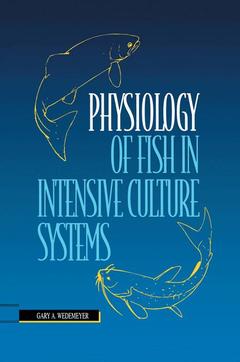Physiology of Fish in Intensive Culture Systems, 1996
Langue : Anglais
Auteur : Wedemeyer Gary A.

Fish culture in hatcheries and other aquacultural facilities is becoming much more intensive all over the world. The success of all kinds of fish rearing depends on the quality of management and this depends, in turn, on understanding the biology of fishes and the aquatic environment in which they live. This book directly addresses the relationship between the aquatic environment and the fishes. An understanding of this by the reader will result in a reduction of disease outbreaks through improved management.
Preface. Acknowledgements. List of Scientific Names. Chapter 1: Introduction: Historical perspective; The aquatic environment; The intensive culture environment. Chapter 2: Basic physiological functions: Introduction; Respiration and oxygen consumption; Blood and circulation; Osmoregulation; Parr-smolt transformation; Feeding, digestion, excretion; Immune protection; Stress response. Chapter 3: Effects of water quality conditions: Introduction; Water quality requirements: acidity; alkalinity; ammonia; carbon dioxide; chlorine; dissolved oxygen; hardness; heavy metals; hydrogen sulfide; nitrate, nitrite; supersaturation; temperature; Total dissolved solids, salinity; Total suspended solids, turbidity; summary; Disease problems associated with water quality conditions: Gas bubble disease (Gas bubble trauma); Methemoglobinemia (Brown blood disease); Visceral granuloma and nephrocalcinosis; Blue sac disease (Hydrocele embronalis); White spot (Coagualted yolk) disease; Soft shell disease (Soft egg disease); Algal toxins. Chapter 4: Effects of fish cultural procedures: Introduction; Crowding; Transportation; Formulated diets/adventitious toxins; Effects of smolt development; Chapter 5: Biological interactions during rearing: Introduction; Interactions between fish; Interactions between fish and microorganisms: fish-pathogens-environment relationship; Infection into disease:mechanisms; Stress-mediated diseases; Diseases as indicators of environmental quality; Managing biological interactions to prevent diseases. Chapter 6: Methods to minimize pathogen exsposure: Introduction; Biological methods; water treatment systems: Chloration; Ultraviolet light; ozone. Introduction: Basic physiological functions; Effects of water quality conditions; Effects of fish cultural procedures; Biological interactions during rearing; Methods to minimize pathogen exposure.
This book directly addresses the relationship between the aquatic environment and the fishes. An understanding of this by the reader will result in a reduction of disease outbreaks through improved management. It bridges the gap between standard aquaculture methods books and specialized fish physiology textbooks. It provides fish disease specialists with the basic technical information needed to provide a low-stress rearing environment that will minimize or prevent infectious and non-infectious disease problems and costly production losses.
Date de parution : 09-2012
Ouvrage de 232 p.
15.2x22.9 cm
Thème de Physiology of Fish in Intensive Culture Systems :
Mots-clés :
Osmoregulation; biology; environment; fish; fish culture; physiology; temperature
© 2024 LAVOISIER S.A.S.



